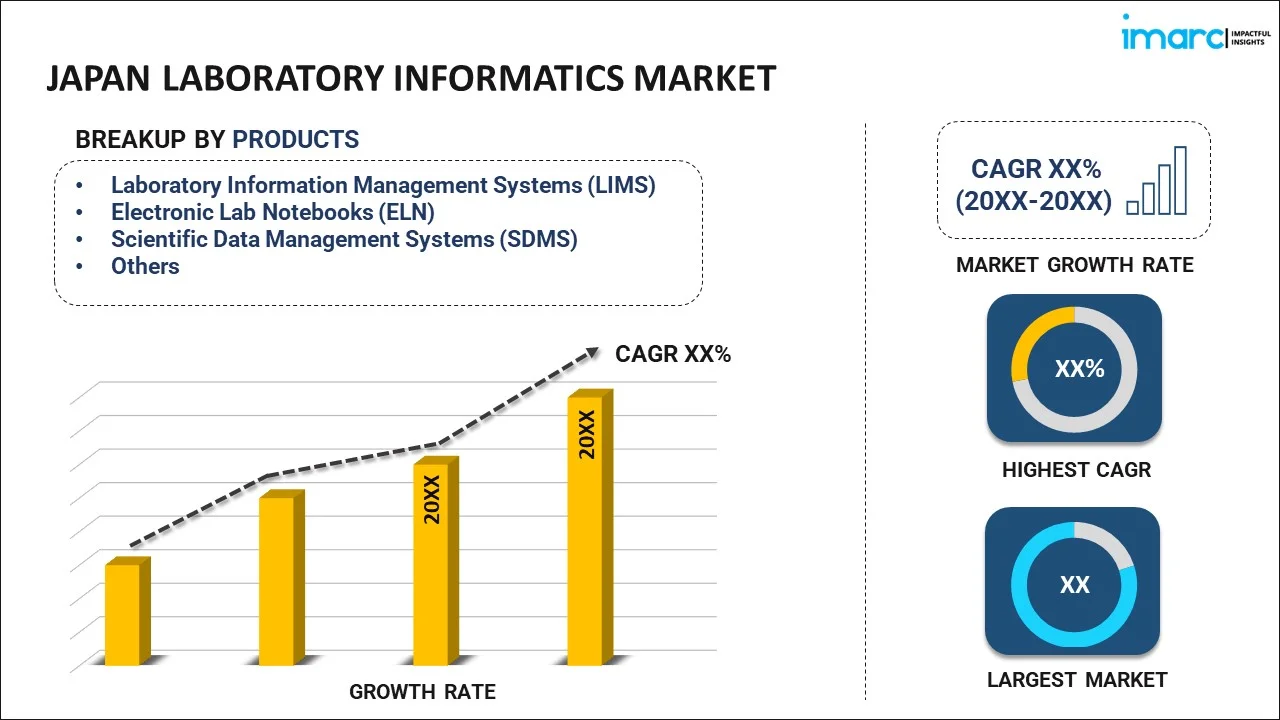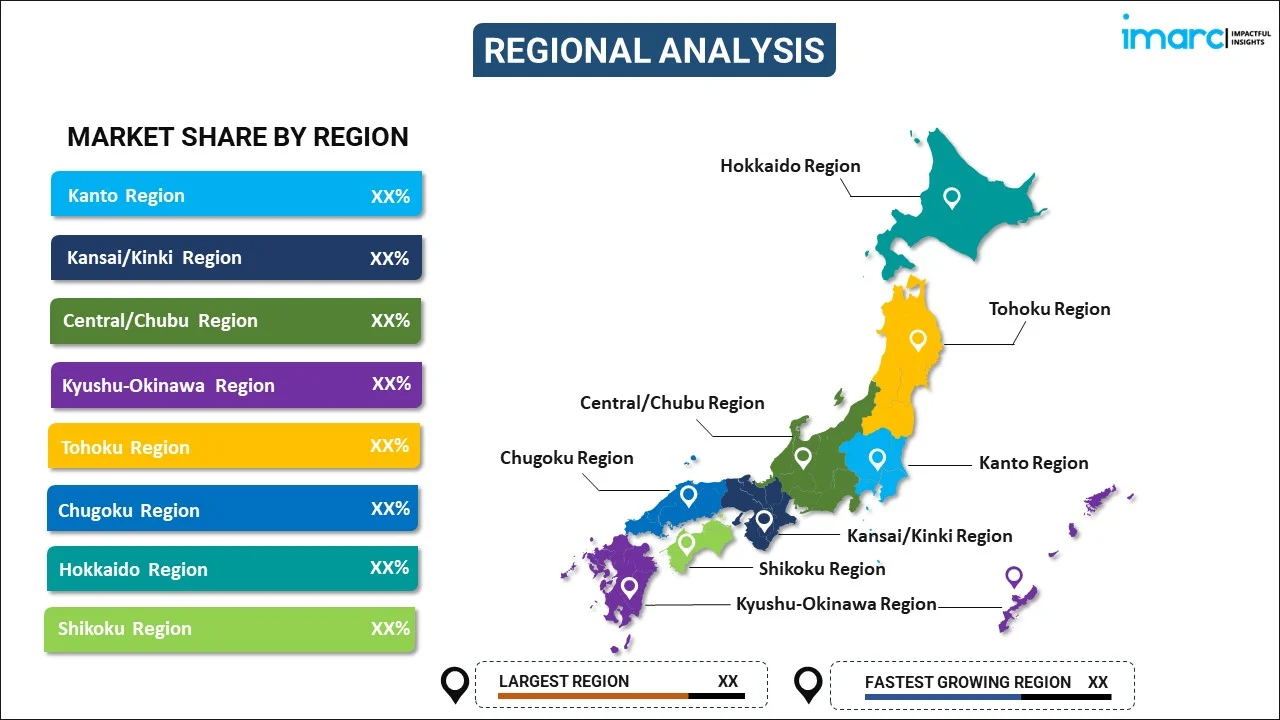
Japan Laboratory Informatics Market Report by Product (Laboratory Information Management Systems (LIMS), Electronic Lab Notebooks (ELN), Scientific Data Management Systems (SDMS), Laboratory Execution Systems (LES), Electronic Data Capture (EDC) and Clinical Data Management Systems (CDMS), Chromatography Data Systems (CDS), Enterprise Content Management (ECM)), Delivery Mode (On-premises, Web-hosted, Cloud-based), Component (Software, Services), End User (Life Science Companies, CROs, Chemical Industry, Food and Beverage and Agriculture Industries, Environmental Testing Laboratories, Petrochemical Refineries and Oil and Gas Industry, and Others), and Region 2025-2033
Market Overview:
Japan laboratory informatics market size reached USD 172.1 Million in 2024. Looking forward, IMARC Group expects the market to reach USD 277.4 Million by 2033, exhibiting a growth rate (CAGR) of 5.04% during 2025-2033. The rapid advancements in technology, such as the Internet of Things (IoT), artificial intelligence (AI), machine learning (ML), and cloud computing, which have significantly enhanced the capabilities of laboratory informatics systems, are driving the market.
|
Report Attribute
|
Key Statistics
|
|---|---|
|
Base Year
|
2024
|
|
Forecast Years
|
2025-2033
|
|
Historical Years
|
2019-2024
|
|
Market Size in 2024
|
USD 172.1 Million |
|
Market Forecast in 2033
|
USD 277.4 Million |
| Market Growth Rate 2025-2033 | 5.04% |
Laboratory informatics is the field that integrates information technology with laboratory operations to enhance the efficiency, accuracy, and overall management of scientific research and experimentation. It encompasses the use of software, hardware, and data management systems to streamline various laboratory processes, such as sample tracking, data analysis, and reporting. Laboratory information management systems (LIMS), electronic lab notebooks (ELNs), and scientific data management systems (SDMS) are common tools in laboratory informatics. These systems help researchers organize and access data, maintain compliance with regulatory requirements, and facilitate collaboration among team members. Laboratory informatics plays a critical role in industries like pharmaceuticals, healthcare, environmental monitoring, and materials science, where precise data management and adherence to quality standards are crucial. It allows scientists to make data-driven decisions, accelerate research timelines, and ensure the reproducibility of experiments. In a rapidly evolving technological landscape, laboratory informatics continues to advance, enabling laboratories to stay at the forefront of scientific innovation.
Japan Laboratory Informatics Market Trends:
The laboratory informatics market in Japan is experiencing significant growth due to a confluence of several key drivers. Firstly, the escalating demand for efficient data management and analysis tools in R&D processes has fueled market expansion. Secondly, the increasing adoption of cloud-based solutions and advanced data analytics techniques has catalyzed the growth of the laboratory informatics sector. Moreover, the imperative need for compliance with stringent regulatory requirements, such as those in the healthcare and pharmaceutical industries, has propelled the demand for informatics solutions. Furthermore, the advent of Industry 4.0 and the integration of laboratory informatics with IoT technologies have augmented market prospects, allowing real-time data monitoring and analysis. Additionally, the rising awareness among enterprises about the advantages of laboratory informatics in streamlining laboratory operations, reducing errors, and enhancing productivity is expected to drive the laboratory informatics market in Japan during the forecast period.
Japan Laboratory Informatics Market Segmentation:
IMARC Group provides an analysis of the key trends in each segment of the market, along with forecasts at the country level for 2025-2033. Our report has categorized the market based on product, delivery mode, component, and end user.
Product Insights:

- Laboratory Information Management Systems (LIMS)
- Electronic Lab Notebooks (ELN)
- Scientific Data Management Systems (SDMS)
- Laboratory Execution Systems (LES)
- Electronic Data Capture (EDC) and Clinical Data Management Systems (CDMS)
- Chromatography Data Systems (CDS)
- Enterprise Content Management (ECM)
The report has provided a detailed breakup and analysis of the market based on the product. This includes laboratory information management systems (LIMS), electronic lab notebooks (ELN), scientific data management systems (SDMS), laboratory execution systems (LES), electronic data capture (EDC) and clinical data management systems (CDMS), chromatography data systems (CDS), and enterprise content management (ECM).
Delivery Mode Insights:
- On-premises
- Web-hosted
- Cloud-based
A detailed breakup and analysis of the market based on the delivery mode have also been provided in the report. This includes on-premises, web-hosted, and cloud-based.
Component Insights:
- Software
- Services
The report has provided a detailed breakup and analysis of the market based on the component. This includes software and services.
End User Insights:
- Life Science Companies
- CROs
- Chemical Industry
- Food and Beverage and Agriculture Industries
- Environmental Testing Laboratories
- Petrochemical Refineries and Oil and Gas Industry
- Others
A detailed breakup and analysis of the market based on the end user have also been provided in the report. This includes life science companies, CROs, chemical industry, food and beverage and agriculture industries, environmental testing laboratories, petrochemical refineries and oil and gas industry, and others.
Regional Insights:

- Kanto Region
- Kansai/Kinki Region
- Central/ Chubu Region
- Kyushu-Okinawa Region
- Tohoku Region
- Chugoku Region
- Hokkaido Region
- Shikoku Region
The report has also provided a comprehensive analysis of all the major regional markets, which include Kanto Region, Kansai/Kinki Region, Central/ Chubu Region, Kyushu-Okinawa Region, Tohoku Region, Chugoku Region, Hokkaido Region, and Shikoku Region.
Competitive Landscape:
The market research report has also provided a comprehensive analysis of the competitive landscape. Competitive analysis such as market structure, key player positioning, top winning strategies, competitive dashboard, and company evaluation quadrant has been covered in the report. Also, detailed profiles of all major companies have been provided.
Japan Laboratory Informatics Market Report Coverage:
| Report Features | Details |
|---|---|
| Base Year of the Analysis | 2024 |
| Historical Period | 2019-2024 |
| Forecast Period | 2025-2033 |
| Units | Million USD |
| Scope of the Report | Exploration of Historical and Forecast Trends, Industry Catalysts and Challenges, Segment-Wise Historical and Predictive Market Assessment:
|
| Products Covered | Laboratory Information Management Systems (LIMS), Electronic Lab Notebooks (ELN), Scientific Data Management Systems (SDMS), Laboratory Execution Systems (LES), Electronic Data Capture (EDC) and Clinical Data Management Systems (CDMS), Chromatography Data Systems (CDS), Enterprise Content Management (ECM) |
| Delivery Modes Covered | On-premises, Web-hosted, Cloud-based |
| Components Covered | Software, Services |
| End Users Covered | Life Science Companies, CROs, Chemical Industry, Food and Beverage and Agriculture Industries, Environmental Testing Laboratories, Petrochemical Refineries and Oil and Gas Industry, Others |
| Regions Covered | Kanto Region, Kansai/Kinki Region, Central/ Chubu Region, Kyushu-Okinawa Region, Tohoku Region, Chugoku Region, Hokkaido Region, Shikoku Region |
| Customization Scope | 10% Free Customization |
| Post-Sale Analyst Support | 10-12 Weeks |
| Delivery Format | PDF and Excel through Email (We can also provide the editable version of the report in PPT/Word format on special request) |
Key Questions Answered in This Report:
- How has the Japan laboratory informatics market performed so far and how will it perform in the coming years?
- What has been the impact of COVID-19 on the Japan laboratory informatics market?
- What is the breakup of the Japan laboratory informatics market on the basis of product?
- What is the breakup of the Japan laboratory informatics market on the basis of delivery mode?
- What is the breakup of the Japan laboratory informatics market on the basis of component?
- What is the breakup of the Japan laboratory informatics market on the basis of end user?
- What are the various stages in the value chain of the Japan laboratory informatics market?
- What are the key driving factors and challenges in the Japan laboratory informatics?
- What is the structure of the Japan laboratory informatics market and who are the key players?
- What is the degree of competition in the Japan laboratory informatics market?
Key Benefits for Stakeholders:
- IMARC’s industry report offers a comprehensive quantitative analysis of various market segments, historical and current market trends, market forecasts, and dynamics of the Japan laboratory informatics market from 2019-2033.
- The research report provides the latest information on the market drivers, challenges, and opportunities in the Japan laboratory informatics market.
- Porter's five forces analysis assist stakeholders in assessing the impact of new entrants, competitive rivalry, supplier power, buyer power, and the threat of substitution. It helps stakeholders to analyze the level of competition within the Japan laboratory informatics industry and its attractiveness.
- Competitive landscape allows stakeholders to understand their competitive environment and provides an insight into the current positions of key players in the market.
Need more help?
- Speak to our experienced analysts for insights on the current market scenarios.
- Include additional segments and countries to customize the report as per your requirement.
- Gain an unparalleled competitive advantage in your domain by understanding how to utilize the report and positively impacting your operations and revenue.
- For further assistance, please connect with our analysts.
 Inquire Before Buying
Inquire Before Buying
 Speak to an Analyst
Speak to an Analyst
 Request Brochure
Request Brochure
 Request Customization
Request Customization




.webp)




.webp)












